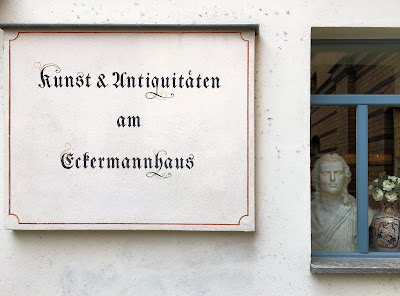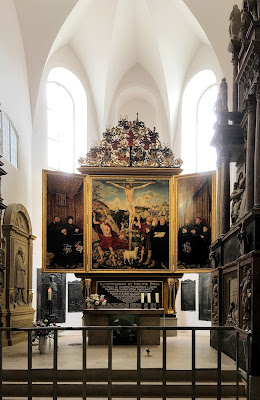Going by train in Germany is generally smooth, except when changing trains. This time, however, my trouble started earlier. When I asked the waiter for my traditional pot of coffee and Butterkuchen, he could only serve me a coffee. As compensation and a new experience, I got my connecting train in Fulda this time. As it was already late and not having eaten anything worth mentioning during the day, I went directly to the dining car and ordered a schnitzel with salad.
 |
| Schweineschnitzel with some sort of ratatouille and mixed salad with balsamic dressing |
 |
| Butterkuchen in the light of the setting sun. Note the iPad mini that I use when traveling. |
The following morning I met my Group for breakfast. The bus took us to Weimar. In the past, I blogged about essential aspects of Goethe's town several times, so during the present visit, I was looking for new perspectives, although Weimar's reception was something to get used to.
Somewhat perturbed, we passed the Nationaltheater with the famous statue celebrating the curious friendship between Goethe and Schiller.
After the First World War, the place became famous when a German national assembly met at the theater, deliberated, and eventually passed the so-called Weimar Constitution.
 |
| The Bauhaus designed the memorial plate on the left in the photo of the Nationaltheater. |
 |
| The main building. Note the studio windows facing north for a "neutral" illumination. |
 |
| Read those famous names teaching Formenlehre at the Bauhaus. |
 |
| Students in the Bauhaus hallway |
 |
| The river Ilm |
 |
| Visual axis pointing to Weimar's castle tower |
 |
| Weimar castle and castle bridge |
 |
| Carl August, showing Goethe's facial profile and more |
Here I am human, here I am entitled to be!
Here am I human; here I am allowed to be so!
Here I am Man, here dare it to be!
Here I am of humankind; here I am free to be human!
Here I am human; here I may be so!
Here I am human, here I can be it, unhampered!
Make your favorite choice.
I spent the beginning of the afternoon at the Bauhaus Museum just opposite the Nationaltheater. On my way, I passed the Eckermannhaus with Schiller looking out the window. During Goethe's last years, Johann Peter Eckermann served him as secretary.
The exhibition at the Bauhaus Museum shows lots of graphics by Lyonel Feininger. I shall present a typical one in my future blog about Halle.
 |
| Feininger created some untypical houses while working at the Bauhaus in Weimar. |
Outside the church, carriage horses keep Weimar tidy but not their tails.
On our way to Leipzig, our Group passed Naumburg in the afternoon, where we spent two hours at the cathedral. The Naumburger Dom is better known to the layperson for its Stifterfiguren (founder figures, i.e., the sponsors).
 |
| Smiling, Reglindis greets the visitors. |
 |
| The two Gothic steeples |
 |
| Carvings at the pulpit. Newly installed von Amsdorf in the eerie red of a co-traveler's focusing light while Luther points as usual to the Word. The Bible is all that counts. |
 |
| Entrance to the choir with the founder figures |
 |
| Everybody knows Uta, and some, her husband, Ekkehard. |
 |
| Hermann von Meißen and his wife Reglindis. She was only 23 years when she died. |









No comments:
Post a Comment